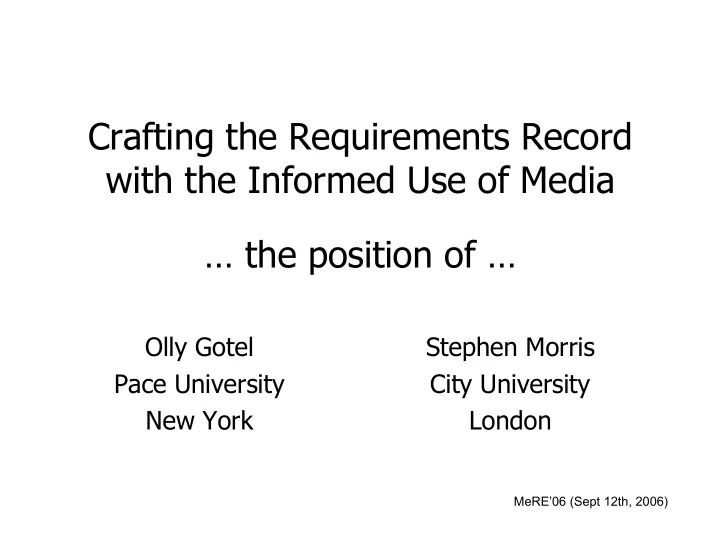

Crafting the Requirements Record with the Informed Use of Media … the position of … Olly Gotel Stephen Morris Pace University City University New York London MeRE’06 (Sept 12th, 2006)
Rich Pictures? Photo by Stephen Morris MeRE’06 (Sept 12th, 2006)
Some Terminology • Medium (s); Media (pl): – Abstract media – Physical media • Multiple media • Multimedia MeRE’06 (Sept 12th, 2006)
Structured Interview George A Colburn interviews President Richard M Nixon (Starbright Images photo) MeRE’06 (Sept 12th, 2006)
Fig 1 from paper: Transformations of communicative media in requirements engineering Abstract media (sign systems) Physical media (carriers) Requirements used in requirements elicitation used in elicitation products documentation [Abstract media after analysis] {Modelling system} Text Printed questions Analyse Formalised (some answers) dialogue on paper Direct Elicit information Samples from interview Speech Sound extraction [Unstructured text] Formalised recording {PMS: primary dialogue (on tape) modelling system} Transcription Sounds proper Video images Use case description to domain (on tape) [Structured text] Interview by {SMS: secondary questionnair Extraction of modelling system} e contextual Graphics Diagram information (any substrate) Use case diagram Images Still images [Diagrams particular (any substrate) to process] Structuring {TMS: tertiary and Moving Domain data modelling system} representatio pictures (any substrate) n Single virtual Simplification! Other sign (i.e. digital) medium systems particular to domain MeRE’06 (Sept 12th, 2006)
Media Transformations Partial list • 12 Constructive & supportive types: – origination (initial creation of medium element) – substitute creation ( creation of element in one medium to stand in place of element already realised in another medium) – translation ( element in one medium replaces element in another medium) – revision ( element in one medium supplants an element in the same medium via any type of alteration) – merger ( combination of elements of same medium to form a new element of the same type) MeRE’06 (Sept 12th, 2006)
Work Process MeRE’06 (Sept 12th, 2006)
O Original documents 0.1 origination (in some pre-production process) of documents describing work process [text, graphic, image] 0.2 origination (in some pre-production process) of transparencies used in staff training [graphic, image, text] 1 Live walkthrough/demo 1.1 origination of recorded commentary [speech] 2 Transcription 2.1 translation from recorded commentary in 1 to text transcription [text] 2.2 substitute created for original commentary 3 Screen dumps from repeated demo run 3.1 origination of set of screen dumps [image] from a run of the demo 3.2 substitute use of text transcription from 2 as a guide for the transformation in 3.1 3.3 revision of text transcript [text, graphic] from 2 with embedded notes indicating position of principal screen changes 4 Screen images for multimedia demo 4.1 revision of screen dumps [image] from 3 4.2 revision of images etc. in transparencies [image, graphic] from 1 4.3 merger of individual dumps from 4 to form initial set of demo images [image, graphic] 4.4 substitute creation of demo image list [text] 5 Text keyed to images 5.1 revision of text from transcription in 2 to form script [text, graphic] providing marked blocks of text 5.2 use of substitute image list created in 4 5.3 amalgamation of text from 5.1 with image symbols from 4.4 to show relationship between images and text [text, graphic] 5.4 creation of proxy for final commentary [text] MeRE’06 (Sept 12th, 2006) …production process continues (not all shown)…
Use of Media in RE • Requirements record is a designed artifact: – Users and anticipated use – Communicative intent • If it is to be a multimedia artifact, we need to understand the design process • Process for informed decision making: – Media choices – Combining and integrating media – Transformations between media – Focus on ‘content’ rather than ‘carrier’ MeRE’06 (Sept 12th, 2006)
To Take-Away… • Requirements specifications belong to a particular genre of multiple media (or multimedia if documents are all held from start to finish in digital form) and this genre itself demands more careful definition • Propose framework to examine in terms of abstract/physical media use and the transformations employed in production • Need properly definable continuity for traceability – make process explicit MeRE’06 (Sept 12th, 2006)
Key Reference • Morris, S.J. Media transformations for the representation and communication of multimedia production activities . In Sutcliffe, A. et al. (Eds), Designing Effective and Usable Multimedia Systems. Proceedings of the IFIP Working Group 13.2 Conference on Designing Effective and Usable Multimedia Systems, Stuttgart, Germany, September 1998. Norwell Mass.: Kluwer Academic Publishers, 1998, pages 72 to 85 MeRE’06 (Sept 12th, 2006)
Recommend
More recommend